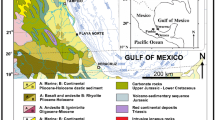Abstract
Post-mortality alteration of brachiopod shells under normal environmental conditions leads to high taphonomic loss, and to a poor contribution to the biodetrital soft sediment. The successive stages of alteration which shells undergo are: (bio)degradation of the organic matrix → shell softening → structural disaggregation or/and mechanical fragmentation; these processes depend on the shell structure (number of layers) and composition (organic and inorganic components), but very little on environmental conditions, except for the dissolution of inorganic shell constituents. Among the Brachiopoda, three types of alteration occur to different types of shells — Type I: two-layered chitino-phosphatic shell (species ofLingula andGlottidia) displays a rapid degradation of the organic matrix and mechanical abrasion, leading to total disappearance of the shell in 2 to 3 wk; Type II: two-layered carbonate shell, e.g.Terebratulina spp. [but notNotosaria nigricans (Sowerby) which may constitute a fourth shell type], exhibits degradation of the organic matrix of the secondary layer, shell softening, and structural disaggregation leading to shell disintegration in 6 to 7 mo with a concomitant contribution of calcitic microfibres to the sediment; Type III: three-layered carbonate shell, e.g.Gryphus vitreus (Born), undergoes organic degradation of the secondary layer, fragmentation of the anterior two-thirds of the shell, and slow degradation (because of the thick tertiary layer) of the posterior portion of the shell, with dissolution of the inorganic components (mainly in the tertiary layer) which make a relatively minor contribution to the sediment.
Similar content being viewed by others
Literature cited
Alexandersson, E. T. (1979). Marine maceration of the skeletal carbonates in the Skagerrak, North Sea. Sedimentology 26: 845–852
Benigni, C. (1985). Morphologia ed ultrastruttura diGryphus vitreus (Born, 1778) dell'Arcipelago Toscano (Italia). Boll. Mus. reg. Sci. nat. Torino 3: 449–498
Benigni, C. (1987). Shell microstructure of Mediterranean terebratulid from Pliocene to recent and its diagnostic significance. Boll. Mus. reg. Sci. nat. Torino 5: 1–26
Boullier, A., Delance, J. H., Emig, C. C., d'Hondt, J. L., Gaspard, D., Laurin, B. (1986). Les populations deGryphus vitreus (Brachiopoda) en Corse. Implications paléontologiques. Biostratigr. Paléozoïque, Brest 4: 179–196
Caulet, J. P. (1972). Les sédiments organogènes du précontinent algérien. Mém. Mus. natn. Hist. nat., Paris 25 (sér. C): 1–295
Collins, M: J. (1986). Post mortality strength loss in shells of the Recent articulate brachiopodTerebratulina retusa (L.) from the west coast of Scotland. Biostratigr. Paléozoïque, Brest 4: 209–218
Curry, G. B. (1982). Ecology and population structure of the Recent brachiopodTerebratulina from Scotland. Palaeontology 25: 227–246
Emig, C. C. (1981). Observations sur l'écologie deLingula reevei Davidson (Brachiopoda: Inarticulata). J. exp. mar. Biol. Ecol. 52: 47–61
Emig, C. C. (1983). Comportement expérimental deLingula anatina (Brachiopoda: Inarticulata) dans divers substrats meubles (Baie de Mutsu, Japon). Mar. Biol. 75: 207–213
Emig, C. C. (1986). Conditions de fossilisation du genreLingula (Brachiopoda) et implications paléontologiques. Palaeogeogr. Palaeoclim. Palaeoecol. 53: 245–253
Emig, C. C. (1987). Offshore brachiopods investigated by submersible. J. exp. mar. Biol. Ecol. 108: 261–273
Emig, C. C. (1989a). Distribution bathymétrique et spatiale des populations deGryphus vitreus (brachiopode) sur la marge continentale (Nord-Ouest Méditerranée). Oceanol. Acta 12: 205–209
Emig, C. C. (1989b). Distributional patterns along the Mediterranean continental margin (upper bathyal) usingGryphus vitreus (Brachiopoda) densities. Palaeogeogr. Palaeoclim. Palaeoecol. 71: 253–256
Emig, C. C. (1989c) Observations préliminaires sur l'envasement de la biocoenose àGryphus vitreus (Brachiopoda), sur la pente continentale du Nord de la Corse (Méditerranée). Origines et conséquences. C. r. hebd. Séanc. Acad. Sci., Paris (sér. III) 309: 337–342
Emig, C. C. (1989d). Les brachiopodes actuels sont-ils des indicateurs (paléo) bathymétriques? Géol. méditerr., Marseille 15: 65–71
Foster, M. W. (1974). Recent Antarctic and Subantarctic brachiopods. Antarct. Res. Ser. 21: 1–189
Fredj-Reygrobellet, D., Fredj, G. (1982). Etat des recherches sur les populations méditerranéennes deGryphus vitreus (Born) de la limite inférieure du plateau continental. Bull. Soc. zool. Fr. 107: 217–223
Gaspard, D. (1986). Aspects figurés de la biominéralisation unités de base de la sécrétion carbonatée chez les Terebratulida actuels. Biostratigr. Paléozoïque, Brest 4: 77–83
Gaspard, D. (1988). Aperçu de la biodégradation des tests de brachiopodes actuels. Conséquences lors de la fossilisation. Association des Sédimentologistes Français, Marseille Colloque n° 7: Biosédimentologie
Iwata, K. (1981). Ultrastructure and mineralization of the shell ofLingula unguis Linné (inarticulate, brachiopod). J. Fac. Sci., Hokkaido Univ. (Ser. 4) 20: 35–65
Iwata, K. (1982). Ultrastructure and calcification of the shells in inarticulate brachiopods. Part 2. Ultrastructure of the shells ofGlottidia andDiscinisca [in Jap.]. J. geol. Soc. Japan 88: 957–966
Jope, H. M. (1965). Composition of brachiopod shells. In: Moore R. C. (ed.) Treatise on invertebrate paleontology. Part H. Brachiopoda. University Kansas Press & Geological Society of America, New York, p. 156–164
Jope, H. M. (1971). Constituents of brachiopod shells. Comp. Biochem. 26C: 749–783
Logan, A., Noble, J. P. A. (1971). A recent shallow-water brachiopod community from the bay of Fundy. Marit. Sediments 7: 85–91
Mackinnon, D. I., Williams, A. (1974). Shell structure of terebratulid brachiopods. Palaeontology 17: 179–202
Mundlos, R. (1978). Terebratulid shell beds. Neues Jb. Geol. Paläont. Abh. 157: 45–47
Noble, J. P. A., Logan, A., Webb, G. R. (1976). The RecentTerebratulina community in the rocky subtidal zone of the bay of Fundy, Canada. Lethaia 9: 1–17
Poulicek, M. (1983). Patterns of mollusk shell biodegradation in bathyal and abyssal sediments. J. mollusc Stud. (Suppl.) 12A: 136–141
Stewart, I. R. (1981). Population structure of articulate brachiopod species from soft and hard substrates. N.Z. Jl Zool. 8: 197–207
Thomson, J. A. (1927). Brachiopod morphology and genera (Recent and Tertiary). N.Z. Bd Sci. Art Man. 7: 1–338
Wanatabe, N., Pan, C.-H. (1984). Phosphatic shell formation in atremate brachiopods. Am. Zool. 24: 977–985
Williams, A. (1968). Evolution of the shell structure of articulate brachiopods. Spec. Pap. Palaeont. 2: 1–55
Author information
Authors and Affiliations
Additional information
Communicated by J. M. Pérès, Marseille
Rights and permissions
About this article
Cite this article
Emig, C.C. Examples of post-mortality alteration in Recent brachiopod shells and (paleo)ecological consequences. Mar. Biol. 104, 233–238 (1990). https://doi.org/10.1007/BF01313263
Accepted:
Issue Date:
DOI: https://doi.org/10.1007/BF01313263




